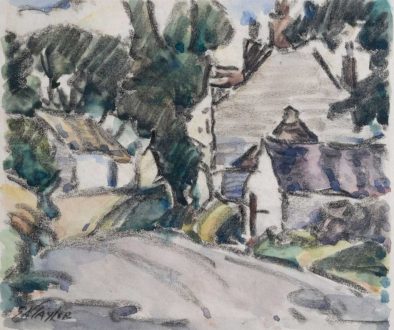On the Trail of Henry Hill
Part of the joy of finding and conserving art on paper, is the investigation of the stories that surround them. Sometimes it is the technique used, sometimes it is information about the artist, and sometimes the provenance – where has it been on its journey?
In 2017 I studied an MA(Res) in the Art Market and the History of Collecting. I wanted to learn some of the more practical skills of researching, than I had when I studied the History of Art, in the early 2000s. I wanted to learn more about using archives and tracing histories. It was a fascinating subject. I was lucky enough to get a scholarship to cover the fees. I spent a year trundling to London once a week on my Wednesday morning National Express coach, staying with my wonderful friend at London HQ, Walthamstow. The course was in partnership with the National Gallery in London. As part of our studies we were able to visit their conservation studio, which was amazing. We also visited archives for some great collections and of course, some of the collections themselves.
I started reading about the Art Market of Victorian England and a name popped up – Henry Hill. This man was the first person to collect Degas in England, but this was the only time he was mentioned. He was a tiny, little footnote in the history of collecting. I decided that he would become the focus of my research project, but there were no surviving personal documents from Henry Hill. Piecing together his story was a challenge.
His collection was sold at Christie’s in London. I was able to spend time in their archive exploring their catalogue listings for the sales of his collection. It was down in the depths of their London headquarters, and the staff there could not have been more encouraging and helpful! I went to Brighton, where he lived and made the base of his collecting. There were some wonderful records at the Brighton Royal Pavilion and the East Sussex Record Office. Again, the library and archive staff were wonderful.
I looked at census records and old newspapers in libraries around London, looking for personal and business records for Henry Hill. The City of Westminster Archive had census records. The London Metropolitan Archives had records of the Tailors Benevolent Institution (Henry Hill had started out his working life as a journeyman tailor). The Victoria and Albert Museum has one of the best art libraries in the world, as well as archive documents of their own collection (aside from the information, it is a beautiful library in which to work, handy for the coach drop off and a great place to hang out!) The British Library is, of course, a treasure trove. All of this gave me a great opportunity to explore London again – something that I had not really done since studying there for my first MA, over 20 years ago. It was, all in all, a great adventure.
It was a wonderful opportunity to get stuck into investigating a story. I had a wallet stuffed full of library cards. It is not easy to access archive records, especially when you don’t quite know what you are looking for. Even with online research and bookings, the many hours of sifting through references means having the time and resources to be able to get to these institutions, which are often only open during the week, and during office hours. There is a strong argument for developing digital archives, to help make research possible for everyone.
It was a real privilege to be able to have had this opportunity. I felt as if I had deserved my deerstalker and pipe by the end of my investigations. To make sure that the research was not lost on a dusty shelf for all eternity, Richard Keenan and I re-created Henry Hill’s collection, using the Christie’s catalogue data. We put it on a website, so that anyone can access the information.
I have recently added my research to the website, so that it is publicly available. I hope that it will be useful, or interesting, or inspire other people to get investigating. With a bit of luck, it may do all three! I am a big fan of making Art History and Art more accessible, and this is part of my contribution. I hope that you enjoy it!
Visit the Henry Hill Website.





